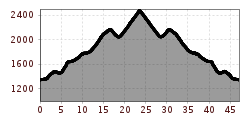Timmelsjoch lies at an altitude of 2,474 meters, surrounded by massive peaks over 3,000 meters. The pass is one of the greatest challenges for road cyclists in the Alps; it is an annual part of the Ötztal Cycling Marathon and has served as a stage finish in the Giro d’Italia (1988) and the Tour Transalp. However, the great effort of the ascent is rewarded with hairpin bends cut unrealistically into the steep slopes and the unforgettable glacier panorama of the Ötztal Alps.

The traffic regulations (StVO) apply. General valid and usual rules of conduct.
It should be noted that road cycling can involve an increased risk of accidents and injuries. Despite careful tour planning, a basic risk always remains. Tour preparation through endurance sports, appropriate training and further education, as well as personal prudence reduces the risk of accidents and hazards.
Personal equipment must be safe, functional, and meet the current technical standards. Every road cyclist is recommended to inform themselves about the planned routes through specialist literature or on site. Full road cycling equipment is absolutely recommended even for experienced riders!
Tip: A light is advisable for the partly sparsely illuminated tunnels.
The northern approach to Timmelsjoch is quite varied – initially still characterized by green vegetation, higher up riders encounter a barren rocky landscape with scree heaps from which the name Timmel originates. Above the tree line and shortly after Hochgurgl at 2,100 meters lies the toll station with Europe’s highest motorcycle museum. The exhibited items (about 230 motorcycles) are a must-see, even for non-motorcyclists. The onward ride for cyclists is free with a separate lane.A short descent follows, which can be used as a rest pause. Here you already get a view of the long ramp through the Timmel valley before the climb steepens again to the pass height at 2,474 m.Along the Timmelsjoch High Alpine Road there is much to discover. Highlights here include the "Steg" at the toll station, the "Smuggler" in the Timmel valley, and the "Pass museum" at the pass height. You can learn more about the history of the Timmelsjoch High Alpine Road and the Ötztal Nature Park here.Before heading back, the Timmelsjoch inn invites you to a well-deserved break. The distant views of the surrounding mountain and glacier world make you forget some hardships.The rapid descent back to Sölden turns into pure, adrenaline-filled fun. Only the 150-meter uphill counter-climb is really tough. This climb has often decided the Ötztal Cycling Marathon or made the descent to Sölden massively difficult for some participants. From here, with few exceptions, you can reach Sölden without exerting power.
Arrival by train
Travel comfortably and safely by train to Ötztal train station. A regular bus departs directly from the station forecourt towards Obergurgl. The bus ride to Sölden takes about 1 to 1.5 hours.
All important information about bus schedules, connections, and taxi companies can be found here.
At the valley stations of the Gaislachkoglbahn and Giggijochbahn, there are sufficient free parking spaces available, and free parking garages are also provided. Parking is free from 8:00 a.m. to 7:00 p.m.
Paid overnight car parking is possible in the Gaislachkogl car park:
more information about overnight parking